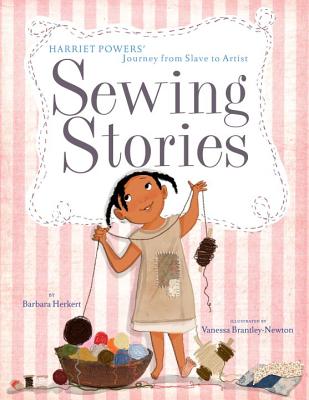Sewing Stories by Barbara Herkert
Today’s pick for Perfect Picture Book Friday is Harriet Powers’ Journey from Slave to Artist Sewing Stories

Written by: Barbara Herkert
Illustrated by: Vanessa Brantley-Newton
Publisher: Alfred A. Knopf (October 2015)
Suitable for ages: 5-8
Themes/Topics: folk-art, quilting, community, survival, determination, resilience, US history, women’s history, slavery, emancipation, Civil War
Brief Synopsis: This story is about the life of Harriet Powers who is not well known, yet whose legacy of early African-American folk art is displayed in the National Museum of American History, part of the Smithsonian Institution in Washington, D.C. and the Museum of Fine Arts in Boston. Even though she lived her early life enslaved and remained poor throughout her adult life, Harriet believed, “You gotta take what you’ve been given and make something out of it.” And that she did.
After enslaved women labored in the fields and or made textiles for the plantation, they used their craft to create story quilts. Over time, sewing became a source of pride and income for Harriet. I imagine the craft had to have helped strengthen her community during the dark times of unfathomable oppression while living either enslaved or free.
Given the recent discussion about the picture book, A Birthday Cake for George Washington, some question why Sewing Stories has not received the same criticism for “smiling slaves”. In my opinion, this book includes facts in the sidebars that touch upon a shameful part of US history while at the same time weaves a story of hope, resilience, determination, and community, despite the oppression. This author does take liberties in a couple sidebars. In this example she intuits, “For a few daylight hours, they might have felt free.” Although sewing and quilting was done for the master, Harriet and her community made the craft their own. After emancipation she used her skills to eventually earn enough to help buy a small farm. The images of characters smiling shows a universal human emotion. Yes, the enslaved had the ability to feel those same human emotions of joy, pride, and hope too. This story is not only about individual pride, it is representative of the grit and struggle people like Harriet demonstrated.
Opening pages: “See that sweet baby girl lying on a quilt her mama made? What could she be dreaming of?
On a plantation near Athens, Georgia, Harriet’s mama worked from rise to set while Harriet slept between the cotton rows.”
Why I like this book: I recently had a discussion with a fellow writer about depicting slavery in picture books. She told me her 5-year-old mentioned something about slaves one day. When probed, he said, “They ran away. Brave people helped them run away and they were safe.”
In a sense, Harriet ran. She ran toward developing a craft that helped her contribute to her family’s income, create a sense of self-worth, and hope for herself, and her community. At the end of the story, Harriet had to sell one of her quilts after falling on hard times. An art teacher named Jennie Smith purchased it, recorded her story, and kept her promise to exhibit it. Jennie was brave.
As writers, we will make mistakes despite our good intentions. But there are many stories that need to be told. For this bright 5-year-old eager to learn, we must continue to create stories that help him understand sensitive and complex topics. And that will take courage.
Resources:
- School & Library Journal listed other picture books that celebrate African-Americans in the Arts here.
- KidLitTV shared Librarian Scott Woods’ list of diverse books –28 Black Picture Books That Aren’t About Boycotts, Buses or Basketball can be found here.
- Lee & Low’s collection of books to celebrate Black History Month can be found here.
- Addressing the topic of slavery in the elementary classroom can be found here.
- Check out author Susanna’s Hill’s Perfect Picture Book page here.
Happy Reading!
I think there are ways to introduce small children to the concept of slavery, adding more details as they grow older. At this age, parents are normally discussing the books with the child, so I don’t mind if the author doesn’t include all the horrific details. Thanks for the recommendation.
Totally agree, no need for horrific details for young children. The conflict is built in, but no need to ignore it. All narratives about slavery that doesn’t include freedom as part of that story, whether a thought, a wish, a need, resistance, or even a fight, will fall short.
I’ll be looking for this book. While cataloging some historic books at our library, I came upon stories of Harriet Powers – and I thought: gee, I wonder if anyone’s written a kid’s book about her?
A good pick for a biography for sure. Hope you enjoy it as much as I did Sue!
This book is a gem! I love the idea of Harriet sewing messages on the sides of quilts. Thank you for sharing the background on Harriet and this book! I know I would enjoy reading it. It is a story that should be shared.
Amazing story,told well too.